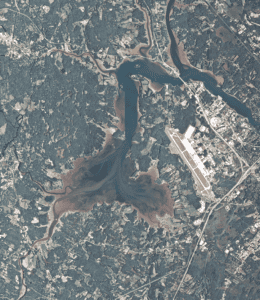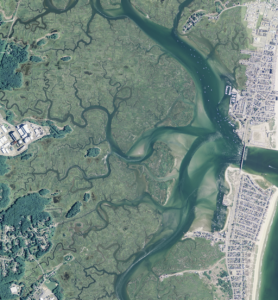Executive Summary
The 2023 State of Our Estuaries Report documents the magnitude of the challenges that face our Great Bay and Hampton-Seabrook Estuaries as well as the Piscataqua Region Watershed. At the same time, it reflects the notable increase in effective collaboration among Piscataqua Region partners over the last five years. Throughout these pages, you will encounter these two themes: the challenges we face are significant, AND so is our power to bring about positive change. To protect and restore our estuaries, we must continue working together toward positive change.
Join us for a journey from the perspective of a juvenile river herring to learn about the stressors facing our estuaries in "A Fish Story." This is a new way to experience what the data tell us about habitats like seagrasses, shellfish, and salt marshes, which continue to struggle with warming waters, extreme weather, and rising seas.
After reading about the herring’s journey, you will notice other additions to this report, such as the “Gulf of Maine Regional Perspective.” These regional trends remind us that our estuaries are part of and interact with a larger system. For example, monitoring in the Gulf of Maine indicates that warmer waters are impacting a copepod, a type of plankton, that provides food for everything from right whales to herring. Conversely, what we do in the Piscataqua Region Watershed affects our estuaries and in turn the Gulf of Maine.
Also new to this report is a long overdue analysis of changes in water clarity, or light, as it relates to eelgrass health. This analysis is an important complement to studies of Total Suspended Solids and Phytoplankton, two indicators with a significant influence on light penetration. The critical message here is that if we can promote light penetration in deeper waters, perhaps we can compensate for shallower waters getting warmer and more stressful for eelgrass.
In this report, as we review the status and trends of our indicators, the story that develops is both concerning and encouraging. Examples of concerning trends include:
- Nitrogen loading from non-point sources increased from the previous period by 15%, influenced in part by increased precipitation in 2017 and 2018. Given forecasts for continued extreme weather, this emphasizes the need to continue improving stormwater management.
- New contaminants of emerging concern are being found in blue mussel tissue at multiple sites in our estuaries; impacts on ecosystem and human health are currently being investigated.
Examples of encouraging developments include:
- Since 2017, 16 more NH communities have adopted more protective stormwater management standards; overall 35 out of 52 communities in the Piscataqua Region Watershed have some level of stormwater standards.
- Nitrogen loading from point sources such as wastewater treatment facilities is at its lowest level since we began regular reporting of this metric in 2003.
- Starting in 2014, eelgrass acreage in the Portsmouth Harbor region has continued to increase.
- There were 5 million oysters at six natural reefs in the Great Bay Estuary in 2020 and 2021. The last time we had more than 5 million oysters was 1998. The region’s oyster aquaculture industry has never been more vibrant; it produced nearly a million oysters in 2021, and 30% of those were used for restoration efforts.
- Finally, propelled by the dam removal in Exeter, total migratory fish returns in the watershed are the highest we’ve seen since 1992!
 In our 2018 Executive Summary, PREP made the case that we needed to work together more effectively. That has certainly happened. For example, the Municipal Alliance for Adaptive Management has improved permit-related decisions between multiple municipalities, the Conservation Law Foundation, U.S. Environmental Protection Agency, and New Hampshire Department of Environmental Services. Now, in 2023, our challenge is to remain vigilant and continue to push the boundaries: both in terms of effective resource management and in terms of effective science to track and understand our changing estuaries.
In our 2018 Executive Summary, PREP made the case that we needed to work together more effectively. That has certainly happened. For example, the Municipal Alliance for Adaptive Management has improved permit-related decisions between multiple municipalities, the Conservation Law Foundation, U.S. Environmental Protection Agency, and New Hampshire Department of Environmental Services. Now, in 2023, our challenge is to remain vigilant and continue to push the boundaries: both in terms of effective resource management and in terms of effective science to track and understand our changing estuaries.